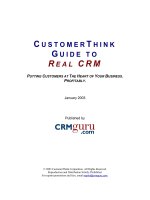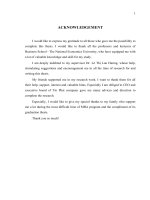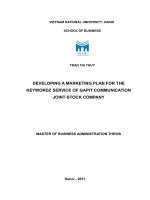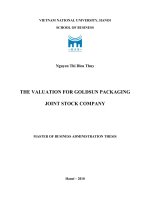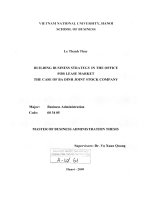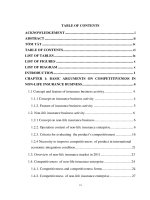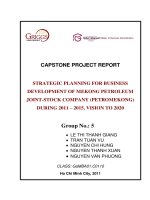Recommendations to relieve container cargo congestion at the port of hai phong joint stock company – chua ve terminal
Bạn đang xem bản rút gọn của tài liệu. Xem và tải ngay bản đầy đủ của tài liệu tại đây (1.82 MB, 66 trang )
MINISTRY OF TRANSPORTATION
MINISTRY OF EDUCATION & TRAINING
VIETNAM MARITIME UNIVERSITY
STUDENT NAME: DO KHANH LY
DISSERTATION
GLOBAL STUDIES AND MARITIME AFFAIRS
RECOMMENDATIONS TO RELIEVE CONTAINER CARGO
CONGESTION AT THE PORT OF HAI PHONG JOINT STOCK
COMPANY – CHUA VE TERMINAL
HAI PHONG – 2015
MINISTRY OF TRANSPORTATION
MINISTRY OF EDUCATION & TRAINING
VIETNAM MARITIME UNIVERSITY
STUDENT NAME: DO KHANH LY
CLASS:
GMA 02
DISSERTATION
GLOBAL STUDIES AND MARITIME AFFAIRS
RECOMMENDATIONS TO RELIEVE CONTAINER CARGO
CONGESTION AT THE PORT OF HAI PHONG JOINT STOCK
COMPANY – CHUA VE TERMINAL
Supervisor: MSc. Hoang Thi Lich
Division:
Global Studies and Maritime Affairs
Faculty:
Economics
HAI PHONG – 2015
Recommendations to relieve container cargo congestion at the Port of Hai Phong Joint Stock
Company – Chua Ve terminal
PREFACE
It is believed that container has made the remarkable revolution in maritime
industry. Indeed, thanks to container shipping, an amount of cargo trading all
around the world has been rising up. In the present age, along with the development
of science and technology, container which is carried on mega ships is no longer
impossibility. And container shipping service has brought huge profits for the
economy.
Vietnam is a country which has got a favorable natural condition with more than
3200 km of coastline. Therefore, maritime transport brings many opportunities and
benefits to the country, especially in container shipping. Although having a natural
advantage along with a growing development of seaports, instead of being able to
gain significant profits from container transportation, Vietnam has to spend an
amount of money in dealing with container cargo congestion at port. The storage of
congested container at port causes the loose of not only an expense but also profits
when a container cannot be used for lease.
Obviously, it can be seen that container cargo congestion is an alarming problem
nowadays. Therefore, understanding and finding feasible solutions for this problem
is a compelling task. This report is written with the aims to have a more thorough
glance at container cargo congestion problem.
I hereby declare that this report is my own work which has not been published
before.
If violated, I am solely responsible for and bear the punishments of the Institution
and University.
Student name and Signature
Do Khanh Ly
Do Khanh Ly – GMA 02
Page i
Recommendations to relieve container cargo congestion at the Port of Hai Phong Joint Stock
Company – Chua Ve terminal
ACKNOWLEGEMENT
Firstly, I owe my deepest gratitude to my advisor MSc. Hoang Thi Lich for the
continuous support of my dissertation, for her patience, encouragement, guidance,
and immense knowledge. She helped me to develop my research as well as many
difficulties during the time I carried out my dissertation.
It is an honor for me to extend my special thanks to staffs at Container Team in
particular and all staffs at Chua Ve terminal in general. They have instructed me
enthusiastically as well as provided information related to my report. Without their
assistance, I would not have fulfilled my dissertation.
Do Khanh Ly – GMA 02
Page ii
Recommendations to relieve container cargo congestion at the Port of Hai Phong Joint Stock
Company – Chua Ve terminal
Table of Contents
PREFACE .............................................................................................................. i
ACKNOWLEGEMENT ....................................................................................... ii
LIST OF ABBREVIATIONS ................................................................................v
LIST OF FIRGUES ............................................................................................. vi
LIST OF TABLES .............................................................................................. vii
INTRODUCTION .................................................................................................1
1.
Necessity of the research ............................................................................1
2.
Research object...........................................................................................1
3.
Research scope ...........................................................................................2
4.
Research findings .......................................................................................2
CHAPTER 1: LITERATURE REVIEW..............................................................3
1.1. An overview of congestion at port ..............................................................3
1.2. Types of congestions at port .......................................................................3
1.3. Causes of cargo congestion at port ..............................................................5
CHAPTER 2: CONTAINER CARGO CONGESTION AT THE PORT OF
HAI PHONG JOINT-STOCK COMPANY – CHUA VE TERMINAL .............9
2.1. Introduction of Chua Ve Terminal ..............................................................9
2.1.1. General information about Chua Ve Terminal ........................................9
2.1.1.1. General information about the Port of Hai Phong Joint-Stock
Company......................................................................................................9
2.1.1.2. General information about Chua Ve Terminal .................................9
2.1.2. Main services ....................................................................................... 10
2.1.3. Infrastructure ........................................................................................ 11
2.1.4. Organization ......................................................................................... 13
2.1.5. Personnel.............................................................................................. 15
2.1.6. Business activity results of Chua Ve Terminal in 2013 and 2014 .......... 16
2.1.7. The total container throughput of Chua Ve Terminal in recent years .... 17
2.2. Container cargo congestion at Chua Ve terminal ......................................... 20
2.2.1. Container cargo congestion at gate ....................................................... 20
2.2.1.1. The real situation ........................................................................... 20
2.2.1.2. Causes of cargo congestion at gate ................................................ 21
Do Khanh Ly – GMA 02
Page iii
Recommendations to relieve container cargo congestion at the Port of Hai Phong Joint Stock
Company – Chua Ve terminal
2.2.2. Container cargo congestion at quay ...................................................... 21
2.2.2.1. The real situation ........................................................................... 21
2.2.2.2. Causes of cargo congestion at quay ............................................... 22
2.2.3. Container cargo congestion at yard ....................................................... 22
2.2.3.1. The real situation ........................................................................... 22
2.2.3.2. Causes of container cargo congestion at yard .................................23
2.2.3.3. The negative influence of accumulated containers ......................... 25
2.3. Evaluation ................................................................................................... 28
2.3.1. Strong points ........................................................................................ 29
2.3.2. Weak points ......................................................................................... 31
CHAPTER 3: RECOMMENDATIONS TO MINIMIZE CONTAINER
CARGO CONGESTION AT THE PORT OF HAI PHONG JOINT STOCK
COMPANY – CHUA VE TERMINAL .............................................................. 34
3.1. Recommendations for Chua Ve terminal ..................................................... 34
3.1.1. Applying information technology ......................................................... 34
3.1.2. Port facilities ........................................................................................ 34
3.1.3. Skills of staffs....................................................................................... 35
3.1.4. Controlling environmental issue ........................................................... 35
3.1.5. Co-ordination with authorities and enterprises ...................................... 36
3.2. Recommendations for governments and involved authorities ...................... 36
3.2.1. For the government .............................................................................. 36
3.2.2. For the involved ministries and parties ................................................. 38
CONCLUSION .................................................................................................... 40
BIBLIOGRAPHY ................................................................................................ 41
APPENDIX I
APPENDIX II
Do Khanh Ly – GMA 02
Page iv
Recommendations to relieve container cargo congestion at the Port of Hai Phong Joint Stock
Company – Chua Ve terminal
LIST OF ABBREVIATIONS
ISO
International Organization for Standardization
DIN
Deutsches Institut fur Normung
UNCTAD
United Nations Conference on Trade and Development
CFS
Container Freight Station
L.O.A
Length of Ship Overall
TEU
Twenty-foot Equivalent Units
CY
Container Yard
RFID
Radio Frequency Identification
Do Khanh Ly – GMA 02
Page v
Recommendations to relieve container cargo congestion at the Port of Hai Phong Joint Stock
Company – Chua Ve terminal
LIST OF FIRGUES
Figure 1: General layout of Chua Ve terminal ........................................................ 10
Figure 2: The diagram of organization at Chua Ve terminal ................................... 13
Figure 3: Financial indicators of business activity .................................................. 16
Figure 4: The container throughput at Chua Ve terminal from 2011 to 2014 .......... 17
Figure 5: The comparison between Tan Vu terminal and Chua Ve terminal in terms
of container throughput from 2011 to 2014 ............................................................ 18
Figure 6: The geographic location of Chua Ve terminal and Tan Vu terminal ........ 19
Figure 7: Facilities at Tan Vu terminal ................................................................... 20
Figure 8: The number of container stagnated at Chua Ve yard since 2006 to 2014 .22
Figure 9: The number of containers stagnated at Chua Ve terminal since 2006 2014....................................................................................................................... 23
Figure 10: Accumulated containers placed outside at Chua Ve yard ...................... 25
Figure 11: Damaged containers at Chua Ve yard ................................................... 26
Figure 12: Yard layout of Chua Ve terminal .......................................................... 27
Figure 13: Block AD ............................................................................................. 27
Figure 14: Block BE .............................................................................................. 27
Figure 15: No. 03/TB-KB form according to the Circular No. 15/2014/TT-BTC ... 30
Figure 16: Cargo dispatching announcement of Chua Ve terminal ......................... 31
Do Khanh Ly – GMA 02
Page vi
Recommendations to relieve container cargo congestion at the Port of Hai Phong Joint Stock
Company – Chua Ve terminal
LIST OF TABLES
Table 1: Storage area at Chua Ve Terminal ............................................................ 11
Table 2: Berth at Chua Ve terminal ........................................................................ 11
Table 3: Equipment at Chua Ve terminal ............................................................... 12
Table 4: Labor structure at Chua Ve terminal......................................................... 16
Table 5: Business activity results of Chua Ve Terminal in 2013 and 2014 ............. 16
Table 6: Labor handling capacity at Chua Ve terminal from 2011 to 2014 ............. 32
Table 7: Comparison between Tan Vu terminal and Chua Ve terminal in terms of
infrastructure ......................................................................................................... 35
Do Khanh Ly – GMA 02
Page vii
Recommendations to relieve container cargo congestion at the Port of Hai Phong Joint Stock
Company – Chua Ve terminal
INTRODUCTION
1. Necessity of the research
Located near the international maritime lane, maritime transportation plays a crucial
role in foreign trade activities of Vietnam. Recent years, thanks to open door
policies of the government and rapid growth of the national economy, especially
acceding World Trade Organization (WTO) on November 2006, the amount of
cargo trading between Vietnam and other nations in the world has been increasing
significantly, especially container cargo.
In the present age, during the process of economic integration of the country, Hai
Phong Port is considered as an important port in bridging trade between the
Northern cities and other provinces and cities as well as between Vietnam and other
nations in the world. With its strategic location along with strong growth of
seaborne trade, instead of gaining significant benefits from container shipping, the
Port of Hai Phong Joint Stock Company has been faced container congestion which
affected detrimentally to business activity of the company as well as the society.
Regarding to Chua Ve terminal – a branch of the Port of Hai Phong Joint Stock
Company, the terminal is specialized in handling container cargo. Recent years,
Chua Ve terminal has been suffered consequences from container cargo congestion
at gate, quay and yard. This problem causes a loss of revenue including storage
charge and other cost related to cargo storage, a time-consuming stay of ships and
cargo at port meanwhile “time is money” in maritime field and so on. Container
cargo congestion not only influences directly to Chua Ve terminal but also national
economy and society in general.
Therefore, the topic “Recommendations to minimize container congestion at the
Port of Hai Phong Joint Stock Company – Chua Ve terminal” is chosen in order to
have a deep glance at this problem, understanding thoroughly reasons and find
feasible solutions for container cargo congestion at Chua Ve terminal.
2. Research object
Container cargo congestion at Chua Ve terminal – a branch of the Port of Hai Phong
Joint Stock Company
Do Khanh Ly – GMA 02
Page 1
Recommendations to relieve container cargo congestion at the Port of Hai Phong Joint Stock
Company – Chua Ve terminal
3. Research scope
-
The Port of Hai Phong Joint Stock Company – Chua Ve terminal
-
Period: 2006 - 2015
4. Research findings
-
Finding workable solutions for Chua Ve terminal so that they can utilize their
capacity by circulating container cargo smoothly.
-
Besides, seeking for appropriate responses towards cargo congestion for
enterprises as well as involved parties.
Do Khanh Ly – GMA 02
Page 2
Recommendations to relieve container cargo congestion at the Port of Hai Phong Joint Stock
Company – Chua Ve terminal
CHAPTER 1: LITERATURE REVIEW
1.1.
An overview of congestion at port
Congestion at port can present numerous ways of appearance. It could be witnessed
either in congestion costs or in queue which are increasingly accumulated, being
featured visually (Meersman, Voorde, & Vanelslander, 2012).
A port typically experiences internal bottlenecks in which they are resulted in a
queue; for example: loading and discharging quays, locks, etc. (Blauwens, De
Baere, & Van De Voorde, 2010)
In fact, there is no common norm to define cargo congestion at port so far.
According to Dr. Usman Gidago, congestion in ports is an issue related to delays,
queuing and additional time of voyage and dwell of ships or cargoes at the port (M.
Alderton, 2008). From this point of view, it can be seen that cargo congestion at
port is a part of port congestion in which flow of cargo is interrupted or delayed by
some factors.
1.2.
Types of congestions at port
According to Dr. Usman Gidago, there are some main types of port congestion in
African ports (Gidado, 2015):
-
Ship berth congestion: is primarily caused by many ships at berth or at
anchorage waiting for available berth.
-
Ship work congestion: is mainly caused by delays in procedure for loading
and discharging ship. This can lead to a dwell of ships at port to complete
cargo operation work.
-
Vehicle gate congestion: is primarily caused by congestion or delay of
landward access to the port. If there is any problem occurring on the way to
the port, it could result in queuing of truck coming in and out of the port gate.
This will affect the flow of cargo significantly.
-
Vehicle work congestion: is mainly caused by low efficiency when loading
and unloading cargo.
Do Khanh Ly – GMA 02
Page 3
Recommendations to relieve container cargo congestion at the Port of Hai Phong Joint Stock
Company – Chua Ve terminal
-
Cargo stack congestion: is principally caused by either a stay of cargo at a
storage area beyond allowed hours or days or above a maximum capacity of
a storage space.
-
Ship entry/exit route congestion: happens when there is any stoppage on the
marine side access to the port.
In the chapter 4 of the book “Maritime Logistic: Contemporary Issues”, port
congestion is divided into various categories based on the location and structure of
the port (Meersman, Voorde, & Vanelslander, 2012)
-
Maritime access route: in default of capacity restrictions; for example, in
order to access the port, ship have to adapt its speed depending on tide.
-
Locks: congestion may happen if the numbers of ships which want to use the
lock excess the lock capacity.
-
Berths: in a case of available berth is occupied another ship.
-
Loading and unloading: when all berths are employed, there coud be a
shortage of loading and unloading equipment.
-
Storage area: in storage area, bad configuration or unexpected moves may
impose a waiting time on cargo or ships.
-
Custom inspection: the procedure of custom inspection may result in
congestion at the point where cargo arrive or depart. The security checks
may worsen the flow of cargo.
-
Hinterland loading and unloading: the employment of specific hinterland
mode of transport may cause disruption or delays, influencing the port
operation as well. In case of truck use, gate area is often the bottleneck at the
port.
-
Hinterland connections: if hinterland infrastructure is utilized excessively
where the port is located in crowded city, there is probably delays in
delivering cargo at the port.
In above classification of port congestion, it can be said that there are two main
types of port congestion including cargo congestion and ship congestion. In terms of
Do Khanh Ly – GMA 02
Page 4
Recommendations to relieve container cargo congestion at the Port of Hai Phong Joint Stock
Company – Chua Ve terminal
cargo congestion, there are three main types of congestion depending on the
location and structure of the port.
-
Cargo congestion at gate: this type of congestion related to vehicle gate
congestion. In case of truck carrying container cargo enter or depart from the
port, if there is any delay or interruption of landward access to the port,
container cargo will also be congested.
-
Cargo congestion at storage area: it could be either a stay of cargo at storage
area beyond allowed time or excess a maximum capacity of storage area.
-
Cargo congestion at quay: this type of congestion related to loading and
unloading process when there is a shortage of handling equipment.
1.3.
Causes of cargo congestion at port
Obviously, it is important to identify causes of delays so as to find appropriate
solutions to solve. According to Professor Patrick M. Alderton, there are some
causes of port congestion related to freight congestion at port (Alderton, 2008)
(1) Planning
-
Inadequacy of inland transport, both in capacity and efficiency, in relation to
trucks, wagons, highways and port access routes.
-
Failure to keep traffic forecast updated to reflect changes in the pace of
major economic developments,
-
Failure of port management and planning authorities to make adequate plans
in time for port management.
-
Inflexibility in development plans to allow later changes in mode of traffic
flows.
-
Political and social interference which bear on decision-making processes.
(2) Management
-
Lack of continuity in senior port management positions.
Do Khanh Ly – GMA 02
Page 5
Recommendations to relieve container cargo congestion at the Port of Hai Phong Joint Stock
Company – Chua Ve terminal
-
Senior port management chosen without regard for the qualifications
required by the job and the adequate provision for upgrading knowledge.
-
Too little training for other staffs, particularly of the middle management and
operating levels.
-
Lack of direct authority of management to effect remedial actions.
(3) Labor
-
Poor labor relations, leading to insufficient restrictive practices.
-
Problems caused by too much or too little labor, according to circumstances.
-
Insufficient deployment of labor.
-
Failure to adapt working practices to local circumstances, such as the
climate.
-
Lack of training of dockworkers, especially in the use of sophisticated
equipment.
(4) Co-ordination
-
Lack of cooperation between different
organizations working in the port area.
private
and
governmental
-
Inadequate consultation between the port authority and users of the port in
respect of operations and development.
(5) Traffic
-
Irregular traffic due to erratic import and export policies, especially with
regard to bulk purchasing and the granting of import licenses.
-
Cargo stowed at port of loading without regard to efficiency of discharge.
-
Form of packaging and cargo presentation unsuitable for efficient handling at
port.
Do Khanh Ly – GMA 02
Page 6
Recommendations to relieve container cargo congestion at the Port of Hai Phong Joint Stock
Company – Chua Ve terminal
-
Consignees without adequate financial resources physical facilities to take
cargo.
(6) Operations
-
Inappropriate policies which leads to transit facilities being used for longterm storage where space is inadequate, thus reducing berth throughput.
-
Lack of inland or port warehousing facilities, causing cargo to remain too
long in the port transit facilities
-
Lack of reserve capacity to deal with recurring surges of demand placed on
ports.
-
Pilferage and smuggling resulting in tight controls which impede a free and
efficient movement
(7) Maintenance
Inadequate maintenance policies which result in a high proportion of
equipment being out of service due to:
-
Absence of preventative and running maintenance
-
Lack of qualified maintenance personnel
-
Lack of adequate stock of spare parts
-
Insufficient standardization of equipment types
(8) Clearance procedure and documentation
-
Late arriving document
-
Faulty document
-
Outmoded documentation requirement and processing method
-
Outmoded clearance facilities for vessel and cargo
-
Importers allowed to order shipments without sufficient funds to take
delivery on arrival
Do Khanh Ly – GMA 02
Page 7
Recommendations to relieve container cargo congestion at the Port of Hai Phong Joint Stock
Company – Chua Ve terminal
(9) Dynamic effects
-
Emergency diversion and transshipment of cargo destined for another port,
which can bring temporary peaks in quantities of cargo, which a port has to
handle
-
Period of exceptionally bad weather
(10)
-
Function and location of the port
Impossibility of improving back-up land accesses in ports because adjacent
lands have been occupied by urban developments
-
Activities carried out in the port area, not related directly to cargo handling,
which may conflict with higher port throughput.
-
Special difficulties which may occur with traffic of landlocked countries
-
Dislocation of traffic by decisions of neighboring countries if ports are
serving regional trade
Do Khanh Ly – GMA 02
Page 8
Recommendations to relieve container cargo congestion at the Port of Hai Phong Joint Stock
Company – Chua Ve terminal
CHAPTER 2: CONTAINER CARGO CONGESTION AT THE
PORT OF HAI PHONG JOINT-STOCK COMPANY – CHUA
VE TERMINAL
2.1.
Introduction of Chua Ve Terminal
2.1.1. General information about Chua Ve Terminal
2.1.1.1. General information about the Port of Hai Phong Joint-Stock Company
Established in 1874, with more than over 140 years of development, Port of Hai
Phong has become one of the leading port operators in the North of Vietnam.
Located in the triangle economic zone Hanoi – Hai Phong – Quang Ninh, a welldeveloped area with good infrastructure in transport, Port of Hai Phong is the most
popular destination for the export and import activities not only of those provinces
but also of the whole Northern part of the country.
Port of Hai Phong’s main premises are Hoang Dieu Terminal, Chua Ve Terminal,
Tan Vu Terminal and Bach Dang Terminal
From 1st July, 2014, Hai Phong Port has transformed its legal form from Limited
Liability Company into Joint-Stock Company. The company operates under the
international name “Port of Hai Phong Joint-Stock Company”
2.1.1.2. General information about Chua Ve Terminal
Business name: Chua Ve Terminal – Port of Hai Phong Joint Stock Company
Address: No. 5 Chua Ve Street, Dong Hai 1 Ward, Hai An District, Hai Phong
Phone: 0313.765784; Fax: 0313.765784
Chua Ve Terminal is a branch directly under Hai Phong Port which was established
in 1997. Before 1995, Chua Ve Terminal had two areas. In the first area,
departments, transaction and port operation places were built. In wartime and
subsidizing period, port mainly operated general cargoes, aid and exported
agricultural product. In the second area, in a period of war, military cargo and
building materials were operated.
Do Khanh Ly – GMA 02
Page 9
Recommendations to relieve container cargo congestion at the Port of Hai Phong Joint Stock
Company – Chua Ve terminal
Until 1995, because of requirements of separating Chua Ve Terminal into two
enterprises: Chua Ve Stevedoring Enterprise and Doan Xa Stevedoring Enterprise.
Chua Ve Stevedoring Enterprise remained the organization, infrastructure,
transporting vehicles and handling equipment.
After the period of two years 1995 and 1996, being invested by Ministry of
Transport and Hai Phong Port, Chua Ve Enterprise had basically changed in terms
of scale. The enterprise built yard with 70,000 m2, operation building, CFS
warehouse as well as equipped facility and equipment for operation.
In July 2007, Chua Ve Terminal was officially put into operation after renovation
and construction. Until now, Chua Ve Terminal is one of the biggest container
terminals in the North of Vietnam with the handling capacity of 500,000 TEU/year.
Chua Ve Terminal is the international standardized modern container terminal,
operating on the basis of application of information technology, having professional
staffs in the field of management of container port operation. Chua Ve Terminal
constantly improves and enhances customer service quality.
Figure 1: General layout of Chua Ve terminal
2.1.2. Main services
-
Container handling service at berth
-
Yard leasing, forwarding, container stuffing and de-stuffing, reefers storage,
cargo inspection and quarantine.
Do Khanh Ly – GMA 02
Page 10
Recommendations to relieve container cargo congestion at the Port of Hai Phong Joint Stock
Company – Chua Ve terminal
-
CFS warehouse service: Consolidation and distribution
-
120 tons electronic weigh bridge for containerized bulk cargoes.
-
Handling equipment and vehicle repairs. Container cleaning and repair
-
Container and other cargoes transportation by road
2.1.3. Infrastructure
Table 1: Storage area at Chua Ve Terminal
STORAGE
CFS storage
3 300 m2
Container yard
202 110 m2
CFS storage is served to consolidate and break bulk cargo with 3 300 m2. Container
yard is 202 110 m2.
Table 2: Berth at Chua Ve terminal
BERTH
Numbers of berth
05
Total length of berth (meters)
848
Depth alongside (meters)
-8.4
L.O.A (meters)
175
Do Khanh Ly – GMA 02
Page 11
Recommendations to relieve container cargo congestion at the Port of Hai Phong Joint Stock
Company – Chua Ve terminal
This is a specialized container terminal with total 848m length of 05 berths which
are designed according to standard of first level terminal. Chua Ve terminal has
-8.4m deep alongside and 175m L.O.A. Yard area is 150,000 m2 with wharf surface
pressure is 8-16 T/m2, being able to handle 5 ships simultaneously with throughput
capacity about 500,000 TEU/year.
Table 3: Equipment at Chua Ve terminal
EQUIPMENT
CATEGORY
TOTAL
Gantry cranes (QC)
04
Portal cranes (PC)
05
Rubber Tyred Gantry (RTG)
10
Rubber Tyred Mobile Crane
02
Reach Stackers
02
Forklift of all kinds
09
Container tractor, trailers
26
Electronic weighing bridge 120 tons
01
Do Khanh Ly – GMA 02
Page 12
Recommendations to relieve container cargo congestion at the Port of Hai Phong Joint Stock Company – Chua Ve terminal
2.1.4. Organization
DIRECTOR
Deputy Director
of Operation
Operation
Department
Business and
Marketing
Dept.
Deputy Director
of Warehouse
CFS
Warehouse
Deputy Director
of Technique
Techniques and
Materials
Department
Yard Handling
Team
Container
Team
Crane Team
Ship Handling
Team
Security Team
Mechanized
Team
IT Team
Industrial
Hygiene Team
Salary
Department
Administration
and Health
Department
Finance and
Accounting
Department
Figure 2: The diagram of organization at Chua Ve terminal
Do Khanh Ly – GMA 02
Page 13
Recommendations to relieve container cargo congestion at the Port of Hai Phong Joint Stock
Company – Chua Ve terminal
Duties of departments:
-
The board of directors:
o Director: a highest senior leaders in the enterprise with a
responsibility of adapting a target and plan of Hai Phong Port,
guaranteeing employees’ life as well as being legally accountable for
production and business of the enterprise.
o Deputy Directors: a counselor for Director, directly supplying
concrete guidance in production including a output target, price,
materials, forwarding plan, collecting all information about annually,
quarterly and monthly plan in order to inform for Director
-
Departments:
o Salary Department: manage a number of employees, working quality
and monitor the employment of labor in the enterprise
o Finance and Accounting Department: calculate and employ asset,
materials and capital in production and business activities.
o Business and Marketing Department: exploit domestic and foreign
market, negotiate and conduct economic contract.
o Operation Department: work out and conduct a production plan,
discuss and negotiate with involved organizations, cargo owners,
vehicle owners so as to carry out the plan
o Technique and Material Department: in charge of managing technique
and material and ensuring labor safety
o Administration and Health Department: advise Director in terms of
emulation, propaganda, office stationery buying and management;
arrange workplace; welcome domestic and foreign guesses
o Information Technology Department: manage cargo information
system; connect information with MIS system of Hai Phong Port
Do Khanh Ly – GMA 02
Page 14
Recommendations to relieve container cargo congestion at the Port of Hai Phong Joint Stock
Company – Chua Ve terminal
-
Teams:
o Mechanized Team: load and unload cargoes in accordance with
stevedoring solutions; manage vehicle and equipment
o Crane Team: manage vehicle and equipment; ensure technical
condition for vehicle and equipment as well as plan a periodic repair
o Handling Team: handle cargo for ships; handle cargo at warehouse
and yard
o Security Team: ensure security, prevent cargo and asset theft
o Industrial Hygiene Team: clean and repair berth, yard and warehouse;
ensure industrial hygiene in a good manner
o Container Team: conduct freight forwarder through the port; manage
container arrangement at yard; solve forwarding procedure at port;
keep track of the time of container demurrage
o CFS warehouse: manage storage, preserve goods for cargo owners
2.1.5. Personnel
According to Labor structure’s report on December, 2014, Chua Ve Terminal
had total 799 employees including three main labor forces:
-
Direct workers: people who participate directly in production process
(transporting and stevedoring process) creating main products for
enterprise.
-
Service workers: people who serve for production process creating
main products for enterprise.
-
Indirect staffs: people who carry out management of production
process of enterprise.
Do Khanh Ly – GMA 02
Page 15
Recommendations to relieve container cargo congestion at the Port of Hai Phong Joint Stock
Company – Chua Ve terminal
Table 4: Labor structure at Chua Ve terminal
No.
Job title
Total
1
Direct workers
329
2
Service workers
375
3
Indirect staffs
95
2.1.6. Business activity results of Chua Ve Terminal in 2013 and 2014
Table 5: Business activity results of Chua Ve Terminal in 2013 and 2014
Indicators
Unit
Year 2013
Year 2014
Total output
TEU
395,143
378,051
Total revenue
Million VND
369,482
334,002
Total cost
Million VND
257,834
244,266
Profit
Million VND
111,648
89,736
Financial Indicators in 2013 and 2014
400000
350000
Million VND
300000
250000
200000
150000
100000
50000
0
Total revenue
Total cost
Profit
2013
369482
257834
111648
2014
334002
244266
89736
Figure 3: Financial indicators of business activity
Do Khanh Ly – GMA 02
Page 16

